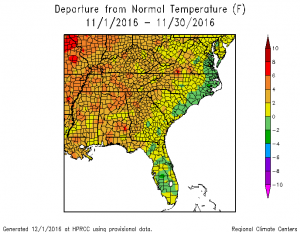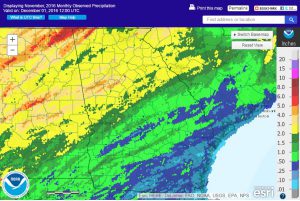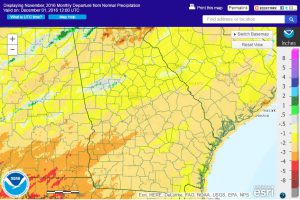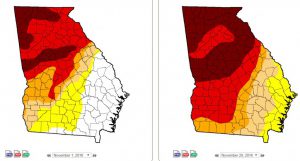Above-normal temperatures were once again the story in most of Georgia in November. The only areas that were cooler than average were the wettest areas from previous months, since the sun’s energy was directed into evaporating soil moisture rather than raising temperatures. In contrast to previous months, the driest part of the state was the southeast, which experienced less than 25% of normal rainfall.
In Atlanta, the monthly average temperature was 58.9 degrees F (4.9 degrees above normal), in Athens 56.8 degrees (3.0 degrees above normal), Columbus 59.9 (2.6 degrees above normal), Macon 58.4 (2.5 above normal), Savannah 61.1 (1.8 above normal), Brunswick 63.5 (1.3 above normal), Alma 60.3 (0.4 above normal), Augusta 57.3 (2.1 above normal), Albany 62.2 (3.5 above normal), Rome 54.9 (4.0 above normal), and Valdosta 61.2 (1.3 degrees above normal).
It was the fourth warmest November on record in 139 years for Atlanta, after 1985, 2001, and 1931.
A number of record highs were tied or set in November. Athens broke their record high on November 3, observing 85 F to pass the old record of 84 F set in 2000. Augusta also broke their record high that day, observing 87 F which surpassed 86 F set in 1974. Alma broke their record high on November 29, observing 82 F which surpassed the old record of 81 F set in 2006.
The highest monthly total precipitation from National Weather Service reporting stations was 2.98 inches in Atlanta (1.12 inches below normal) and the lowest was in Valdosta with just a trace (2.56 inches below normal), although Valdosta’s record was missing the precipitation on the last day of the month. Athens received 2.24 inches (1.58 below normal), Columbus received 2.18 inches (1.92 below normal), Macon 1.15 inches (2.17 below normal), Savannah 0.20 inches (2.17 below normal), Augusta 0.62 inches (2.20 below normal), Alma 0.28 inches (2.20 below normal), Brunswick 0.04 inches (1.99 below normal), Rome 1.77 inches (3.08 below normal) and Albany 1.02 inches (2.17 below normal).
The Brunswick airport station with 0.04 inches was the driest November in 69 years of record, surpassing 2007, which had only 0.06 inches. Savannah was the 7th driest in 147 years of record.
The highest daily rainfall total from CoCoRaHS observers was 3.55 inches near Ringgold in Catoosa County on November 30 with the approaching front, measured in the afternoon. Two observers near Trenton in Dade County reported 3.27 and 3.10 inches that morning, and an observer in Fayetteville in Fayette County reported 3.02 inches on November 29. All of these observers also reported the highest monthly totals, with the Ringgold observer getting 5.12 inches for the month followed by the two Thornton observers with 4.37 and 3.23 inches, and the Fayetteville observer getting 3.16 inches for the month. Note that the rain that fell later in the day on the 30th will be reported by CoCoRaHS observers on the morning of November 1.
The only severe weather reported this month was a single high wind report on the 29th as the cold front began to enter the state and multiple high wind reports and at least four tornadoes observed near Atlanta on November 30.
Drought and dry conditions expanded across the state in November due to the almost complete lack of rainfall and the above-normal temperatures. Even areas hit by Matthew and Hermine earlier in the year were abnormally dry by the end of the month. The Drought Impact Reporter noted that they received several dozen comments about the drought severity from November 11 to Thanksgiving Day.
Many impacts on agriculture were reported in November. Good weather every day helped harvesting of cotton, peanuts and other crops as well as planting of onion sets. But the extremely dry conditions made it impossible to get winter grains and forage planted. Those who did saw their plants germinate and then shrivel from the lack of rainfall. Forest fires in north Georgia and beyond caused respiratory distress in livestock in mid-month and outpatient visits by people with respiratory issues increased due to the heavy smoke in the area. Some farmers reported being afraid to run their farm equipment for fear of sparking more fires in the dry fields.
Irrigation from ponds and streams was curtailed due to the low levels, and several communities requested variances on water restrictions from the State Environmental Protection Division due to problems getting enough water for their communities. Whitewater rafting on the Chattahoochee was also affected because of limited water releases by the Corps of Engineers from Lake Lanier.
The outlook for December shows that a cold outbreak is likely to occur in the second week of the month, with temperatures well below normal. This may feel like a shock to those of us who have been enjoying consistently above-normal temperatures for the last several months. Precipitation is expected to increase just before the cold outbreak. Conditions for the end of the month are expected to be drier and not as cold.
For more information please see the “Climate and Agriculture” blog at https://site.extension.uga.edu/climate/ or visit our web page at https://www.gaclimate.org. Please feel free to email your weather and climate impacts on agriculture to share on the blog to pknox@uga.edu.




